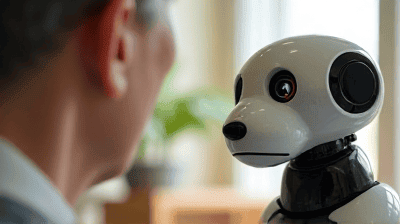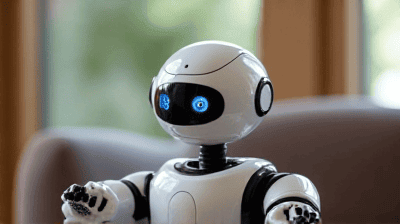
As the global population continues to age, the demand for innovative solutions to enhance elderly care is more critical than ever. In recent years, advancements in artificial intelligence and robotics have led to the development of robotic pets and companions designed to provide emotional support, companionship, and assistance to older adults. These technological innovations are not only redefining how we think about care for the elderly but are also reshaping the landscape of human-technology interactions.
The Evolution of Robotic Pets
A Brief History
Robotic pets are not a new concept, but their design has evolved significantly since the introduction of early robotic toys. The initial forays into companion robotics primarily focused on simplistic interactions and movements. However, with advancements in artificial intelligence, robotics, and machine learning, modern robotic pets have become more sophisticated, capable of simulating a range of emotions and interactions that closely resemble those of real animals.
Milestones in Robotic Pet Development
Pleo (2006): One of the earliest robotic pets, Pleo was designed to mimic a baby dinosaur's behavior. It utilized sensors to respond to touch and sound, allowing users to interact with it in an engaging manner.
Aibo (1999, 2018): Sony's robotic dog has gone through multiple iterations, with the latest version utilizing advanced AI to learn from its environment and interact with its owner in a more lifelike manner. Aibo can recognize faces, respond to commands, and adapt its behavior based on its owner’s actions.
PARO (2003): Developed as a therapeutic robotic seal, PARO is utilized in elderly care facilities to provide comfort and companionship to patients. Its ability to respond to touch and sound makes it effective in reducing stress and anxiety among seniors.
Hanaroo (2019): This robotic cat from the Tokyo-based company has been designed specifically for elderly users. It provides companionship through realistic movements and vocalizations, promoting emotional well-being.
The Technology Behind Robotic Companions
Modern robotic pets are built upon a foundation of several key technologies:
Artificial Intelligence: AI algorithms enable robotic pets to learn from their interactions, allowing them to adapt their behavior and responses over time. This learning capability is essential for creating more engaging and lifelike interactions.
Sensors and Actuators: Equipped with a variety of sensors, including touch, sound, and visual sensors, robotic pets can perceive their environment and respond appropriately to user interactions. Actuators facilitate realistic movements and behaviors.
Speech Recognition: Many robotic companions incorporate speech recognition technology, allowing them to understand voice commands and engage in basic conversations with users.
Connectivity: IoT capabilities enable robotic pets to connect with other smart devices, enhancing their functionality and allowing for remote control or monitoring by caregivers.
The Role of Robotic Pets in Elderly Care

Addressing Loneliness and Isolation
One of the most pressing challenges faced by the elderly is social isolation. Many seniors live alone and may struggle to maintain social connections, leading to feelings of loneliness and depression. Robotic pets serve as a valuable tool for combating these issues. They provide companionship, engagement, and emotional support, helping to alleviate feelings of loneliness.
Benefits of Companionship
Emotional Connection: Robotic pets can create a sense of emotional connection, offering comfort to seniors. Their ability to respond to touch and voice can evoke feelings of love and care similar to those experienced with real pets.
Stress Reduction: Interaction with robotic pets has been shown to reduce stress and anxiety levels. The calming presence of a robotic companion can provide a soothing effect, particularly for those dealing with health issues.
Encouragement of Social Interaction: Robotic pets can also facilitate social interactions. Seniors may encounter fewer barriers when engaging with a robotic companion, which can lead to increased communication and socialization with others.
Enhancing Cognitive Function
Robotic companions can play a role in stimulating cognitive function among the elderly. Engaging with a robotic pet can provide mental exercises that help strengthen memory and cognitive abilities. Activities such as playing games, following commands, and responding to prompts require mental engagement, promoting cognitive health.
Assisting with Daily Activities
In addition to providing emotional support, robotic pets can assist with daily activities, enhancing the quality of life for seniors. Some innovative designs incorporate features that contribute to practical caregiving.
Examples of Daily Activity Assistance
Reminders and Alerts: Robotic companions can be programmed to remind users to take medication, drink water, or engage in physical activity. These gentle nudges can help seniors maintain their health and well-being.
Monitoring Health: Advanced robotic pets can track vital signs and monitor health data, providing caregivers with real-time alerts about potential health issues. This capability is crucial for seniors living alone or with chronic conditions.
Emergency Assistance: Some robotic pets are equipped to detect falls or emergency situations and can alert caregivers or emergency services accordingly, offering an additional layer of safety.
Emotional Benefits of Robotic Pets
Fostering Emotional Attachment
Robotic pets are designed to elicit emotional responses from users, mirroring the bonds formed with live animals. This emotional attachment can provide significant benefits for elderly individuals.
Psychological Well-Being
Research indicates that interactions with robotic pets can lead to improved psychological well-being. The companionship of a robotic animal can reduce feelings of anxiety and depression, making a positive impact on mental health.
Providing Unconditional Love and Acceptance
Unlike human companions, robotic pets do not judge or criticize. They provide unconditional acceptance, allowing seniors to express themselves freely without the fear of social repercussions. This dynamic can be particularly important for individuals who may feel vulnerable or insecure.
Encouraging Physical Activity
Engagement with robotic pets can stimulate physical activity among seniors. For instance, robotic dogs that require walking can motivate individuals to remain active, promoting better physical health while also providing companionship.
Case Studies of Successful Implementation

PARO the Therapeutic Robot
PARO, developed by AIST in Japan, is a robotic seal designed specifically for therapeutic purposes. Studies have shown that PARO effectively reduces stress and anxiety levels in elderly patients, particularly in long-term care settings. Its interactions with patients lead to emotional engagement, resulting in increased happiness and better quality of life.
Aibo as a Companion
The latest version of Sony’s Aibo robotic dog has garnered attention for its advanced AI capabilities. Aibo learns from interactions with its owner, adapting its behavior and responses accordingly. In pilot programs, Aibo has been shown to help mitigate feelings of loneliness among seniors, with users reporting a decreased sense of isolation and a boost in overall mood.
ElliQ the Interactive Companion
ElliQ is a proactive social companion designed for older adults. Equipped with AI, ElliQ engages users in conversation, reminds them of important tasks, and encourages them to connect with family and friends. Studies indicate that interactions with ElliQ lead to improved emotional well-being and reduced feelings of loneliness.
Challenges and Considerations
Acceptance and Adaptation
While the potential benefits of robotic pets are substantial, acceptance among elderly users can vary. Some seniors may be hesitant to embrace technology, while others may find it challenging to adapt. Caregiver education and support in using robotic companions are essential for successful implementation.
Emotional Attachment vs. Reality
While robotic pets can provide emotional support, there remains the question of whether this connection can replace the bond formed with living animals. Understanding the limitations of robotic pets as substitutes for real companionship is vital, and the focus should be on their complementary role in elderly care.
Ethical Considerations
The use of robotic companions in elderly care raises ethical questions concerning dependency and the nature of companionship. Caregivers and healthcare professionals must navigate these issues, maintaining a balance between the benefits of robotic pets and the need for human interaction.
Cost and Accessibility
The cost of advanced robotic pets can be a barrier for many individuals and care facilities. As technology continues to advance and production scales up, pricing may become more accessible, enabling a broader audience to benefit from robotic companionship.
The Future of Robotic Pets and Companions

Technological Advancements
Looking ahead, ongoing advancements in AI and robotics will further enhance the capabilities of robotic pets. Future innovations may include:
Better Emotion Recognition: Improved algorithms for emotion recognition will allow robotic companions to respond more accurately to user emotions, leading to more adaptive interactions.
Enhanced Interactivity: Future robotic pets will likely feature even more lifelike movements and vocalizations, creating a more immersive experience for users.
Greater Customization Options: As developers seek to meet the unique needs of elderly users, robotic pets may offer customized features, such as language settings, activity levels, and personality traits.
Integration with Healthcare Systems
Future developments in robotic pets could lead to their integration with broader healthcare systems. Robotic companions may work in tandem with telehealth services, providing real-time health monitoring and facilitating virtual consultations.
Sustainability Considerations
As society becomes more focused on sustainability, the design and manufacturing of robotic companions may shift towards eco-friendly practices. This shift can include utilizing sustainable materials and creating energy-efficient devices.
Conclusion
In 2024, robotic pets and companions hold immense potential to redefine elderly care and emotional support. Their ability to provide companionship, reduce feelings of loneliness, and assist with daily activities positions them as valuable tools for enhancing the quality of life for older adults. As technology progresses, the emotional and practical benefits of robotic companions will continue to grow, fostering deeper connections and supporting the well-being of seniors.
While there are challenges to address, the evolution of robotic pets represents an exciting intersection of technology and care that promises to reshape the future of elderly assistance. By harnessing the power of artificial intelligence and robotics, we can create a more supportive and compassionate environment for our aging population, enriching their lives and addressing the complexities of elderly care.
Related
-

-
Artificial intelligence

-

-

-

-

